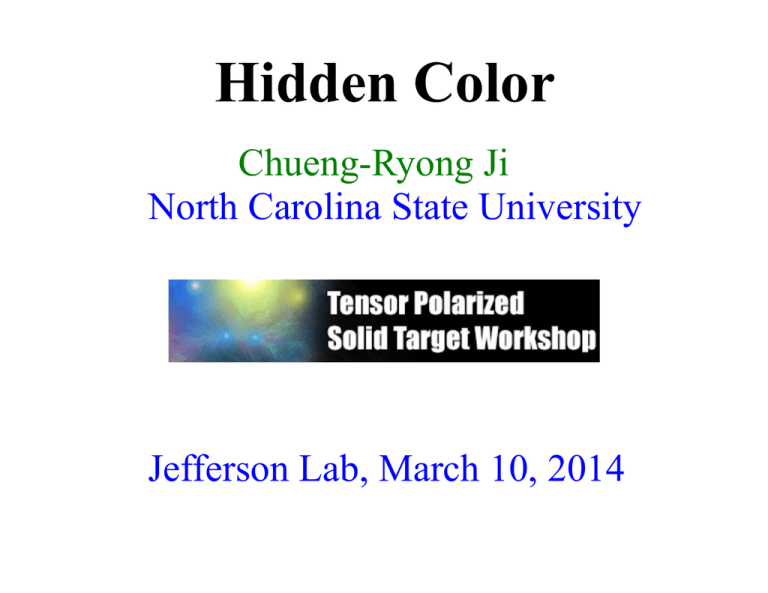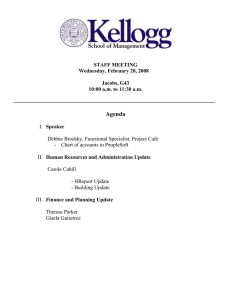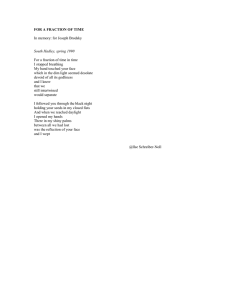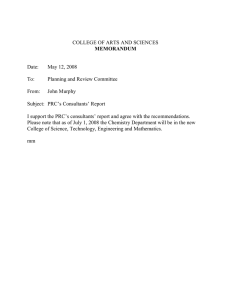Hidden Color - Jefferson Lab
advertisement

Hidden Color
Chueng-Ryong Ji
North Carolina State University
Jefferson Lab, March 10, 2014
Outline
l
Brief Motivation
l
Hidden Color Degrees of Freedom in 6q, 9q, ….
B.L.G.Bakker & C.Ji, Prog. in Part. and Nucl.Phys. 74, 1 (2014)
l
Double Pionic Fusion and “ABC Effect”
M. Bashkanov, S.J. Brodsky, H.Clement, PLB 727, 438 (2013)
l
“RNA” of Deuteron Π0 Photoproduction
S.J.Brodsky,J.R.Hiller,C.Ji,G.A.Miller, PRC 64, 055204 (2001)
l
Summary and Outlook
Mesons
QQ
“tetraquark” states
QQ QQ
Zc (CC UD)
Baryons
Glueball States
QQQ
GG GGG
“pentaquark” states
QQQQQ
“hexaquark” states
QQQ QQQ
F.J.Dyson & N. Xuong, PRL 13, 815 (1964)
“H dibaryon”
UUD DSS R.L.Jaffe, PRL 38, 195 (1977)
Possible mechanisms underlying confinement
multiply as the number of quarks and gluon
constituents increase.
Do the constituents always cluster as color-singlet subsystems?
Predominantly “yes” for ordinary nuclei, but there are also
rare configurations in which other multiquark color
configurations “hidden color” can enter.
! NS = (5 ~ 10)!0
!0 = 2.65 !1014 g / cm 3
!" = 1.4g / cm 3
Large Enhancement of
Hidden Color Effect
is expected.
?
MIT-CTP-1347, Apr 1986 – 8 pages
-------------------------------------------------------------------------------------------------------------------
SU(2) Example:
|Singlet I>1234=|Singlet>12 |Singlet>34
|Singlet II>1234=|Triplet>12 |Triplet>34
=(2|Singlet>13 |Singlet>24 -|Singlet>12 |Singlet>34)/3
1/2
Singlets of quarks and anti-quarks in SU(3) color:
Color singlet in 3-quark system
Color singlet in 6-quark system
(42-1)/(5-1) = 41/4 >10
More than an order of magnitude increase!
B.L.G.Bakker & C.Ji, Prog. in Part. and Nucl.Phys. 74, 1 (2014)
Three-Nucleon Short Range Correlation
E02-019 Hall C Expt, PRL 108, 092502 (2012)
Double-pionic fusion
Wasa-at-COSY
n
!"→#$$
Mikhail Bashkanov, Baryons2013
π
n p
π
p
Abashian-Booth-Crowe (ABC) Effect
A. Abashian, N.E. Booth, K.M. Crowe, PRL 5, 258 (1960)
n
!"→#$$
π
n p
π
p
“σ”
N*
Δ
Δ
pn
→ d π0π0
I=0,1
I=0
I=0
I=0,2
I(Jp) = 0(3+) , M=2.37GeV , Γ=70MeV
“Inevitable” nonstrange dibaryon
T.Goldman et al., PRC 39, 1889 (1989)
J.L.Ping et al., PRC 79, 024001 (2009)
J=3
I=0
l pn
→ d* → ΔΔ → dπ0π0
p
n
Δ
π
d
Δ
π
M. Bashkanov, S.J. Brodsky, H.Clement, PLB 727, 438 (2013)
[6]{33}, S6 “Hidden Color”
[42]{33}, S4P2 “Deltaron”
M.Harvey, NPA 352, 326 (1981)
A.Gal, H.Garcilazo, PRL 111, 172301 (2013)
R.D.Mota et.al., PRC 65, 034006 (2002)
Multiplet
10⊗10=35⊕28⊕27⊕10
Y(ΔΔ)=2
I(ΔΔ)=0
ΔΔ
ΔΣ*
ΔΞ*
ΔΩ
Kim Maltman, Nucl. Phys. A501 (1989) 843
Mirror dibaryon
T.Kamae, T.Fujita, PRL 38, 471 (1977)
D30
d*=D03
I(Jp) = 0(3+)
Δ
u
u
I(Jp) = 3(0+)
Δ
u
d
Δ
d
d
u
u
Δ
u
u
u
u
Mirror Multiplet
Δ-Δ-
10⊗10=35⊕28⊕27⊕10
ΔΔ
ΔΣ*
Σ*Σ*+ΔΞ*
Ξ*Σ*+ΔΩ
Ξ*Ξ*+Σ*Ω
Ξ*Ω
ΩΩ
Δ++Δ++
S.J.Brodsky,J.R.Hiller, PRC 28, 475 (1983)
S.J.Brodsky,J.R.Hiller,C.Ji,G.A.Miller, PRC 64, 055204 (2001)
New Improved Reduced Nuclear Amplitude
Impulse Approximation is valid only for
S.J.Brodsky & C.Ji, PRD 33, 2653 (1986)
Reduced Form Factor
C.Ji & S.J.Brodsky, PRD 34, 1460 (1986);
S.J.Brodsky, C.Ji, G.P.Lepage, PRL 51, 83 (1983);
S.J.Brodsky & C.Ji, PRD 33, 1406 (1986)
Summary and Outlook
Proliferation of hidden color degrees of freedom
is dramatic as the number of quarks increase.
3N SRC may be enhanced as Q gets large.
Q dependence of deuteron b1 structure function may be
important to check the effect of hidden color degrees
of freedom.
Recent observation of d* resonance raises the
possibility of producing other novel color-singlet
six-quark dibaryon configurations allowed by
QCD.
The link between the traditional nuclear physics
and the quark-gluon picture may be provided by
the reduced nuclear amplitudes.


